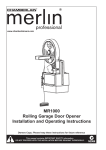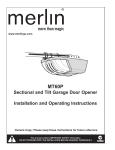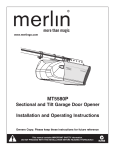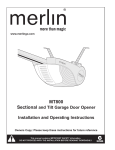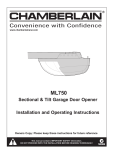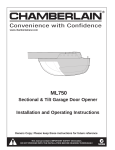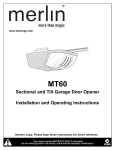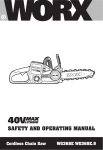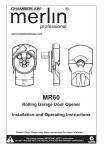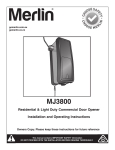Download Merlin Powerlift Operating instructions
Transcript
www.chamberlainanz.com MT230 Sectional and Tilt Garage Door Opener Installation and Operating Instructions Owners Copy: Please keep these instructions for future reference This manual contains IMPORTANT SAFETY information. DO NOT PROCEED WITH THE INSTALLATION BEFORE READING THOROUGHLY. N2966 START BY READING THESE IMPORTANT SAFETY INSTRUCTIONS WARNING • Failure to comply with the following instructions may result in serious personal injury or property damage. • Read and follow all instructions carefully. • The garage door opener is designed and tested to offer safe service provided it is installed and operated in strict accordance with the instructions in this manual. These safety alert symbols mean WARNING : A possible risk to personal safety or property damage exists. Keep garage door balanced. Do not let the garage door opener compensate for a binding or sticking garage door. Sticking, binding or unbalanced doors must be repaired before installing this opener. Do not wear rings, watches or loose clothing while installing or servicing a garage door opener. Frequently examine the door installation, in particular cable, springs and mountings for signs of wear, damage or imbalance. Do not use if repair or adjustment is needed since springs and hardware are under extreme tension and a fault can cause serious personal injury. To avoid serious personal injury from entanglement, remove all ropes, chains and locks connected to the garage door before installing the door opener. Installation and wiring must be in compliance with your local building and electrical codes. The safety reverse system test is very important. Your garage door MUST reverse on contact with a 40mm obstacle placed on the floor. Failure to properly adjust the opener may result in serious personal injury from a closing garage door. Repeat the test once a month and make any necessary adjustments. This opener should not be installed in a damp or wet space exposed to weather. This appliance is not intended for use by persons (including children) with reduced physical, sensory or mental capabilities, or lack of experience and knowledge, unless they have been given supervision or instruction concerning use of the appliance by a person responsible for their safety. The Protector SystemTM must be used for all installations where the closing force as measured on the bottom of the door is over 400N (40kgf). Excessive force will interfere with the proper operation of the Safety Reverse System or damage the garage door. After installation, ensure that the parts of the door do not extend over public footpaths or roads. Install the wireless wall control (or any additional wall control) in a location where the garage door is visible, at a height of at least 1.5m and out of the reach of children. Do not allow children to operate push button(s) or transmitter(s). Serious personal injury from a closing garage door may result from misuse of the opener. Permanently fasten the Warning Labels in Prominent Places, adjacent to Wall Controls and manual release mechanisms as a reminder of safe operating procedures. Activate opener only when the door is in full view, free of obstructions and the opener is properly adjusted. No one should enter or leave the garage while the door is in motion. Do not allow children to play near the door, or door controls. Disconnect electric power to the garage door opener before making repairs or removing covers. KEEP THESE INSTRUCTIONS Warning: If your garage has no service entrance door, a CM1702 outside quick release must be installed. This accessory allows manual operation of the garage door from outside in case of power failure. CONTENTS PAGE SAFETY INSTRUCTIONS . . . . . . . .2 DOOR TYPES . . . . . . . . . . . . . . . . .3 TOOLS REQUIRED . . . . . . . . . . . .3 HARDWARE PROVIDED . . . . . . . .3 BEFORE YOU BEGIN . . . . . . . . . . .4 COMPLETED INSTALLATION . . . .4 ASSEMBLY . . . . . . . . . . . . . . . . .4-5 INSTALLATION . . . . . . . . . . . . .6-10 ADJUSTMENT . . . . . . . . . . . . .11-12 SAFETY REVERSE SYSTEM . . . .12 INSTALL IR SAFETY BEAMS . . . .13 2 AUTO-CLOSE . . . . . . . . . . . . . . . .14 WIRED DOOR CONTROLS . . . . .15 WIRELESS PROGRAMMING .15-16 ACCESSORIES . . . . . . . . . . . . . . .17 REPLACEMENT PARTS . . . . .18-19 DIAGNOSTIC CHART . . . . . . . . .20 TROUBLESHOOTING . . . . . . . . . 21 SPECIFICATIONS . . . . . . . . . . . .22 OPERATION OF YOUR OPENER 22 MAINTAINING YOUR OPENER . .22 CARE OF YOUR OPENER . . . . . .22 WARRANTY . . . . . . . . . . . . . . . . .23 1 DOOR TYPES A. One-piece door with horizontal track only B. Sectional door with curved track A C. One-piece door without track 2 TOOLS REQUIRED 1 3 C B 2 HARDWARE PROVIDED 1 4 2 6 7 9 8 MT230 opener Curved door arm Door mounting bracket Straight door arm Idler Header bracket Trolley assembly Chain and joiner Hardware bag Optional Segmented pole pack 7527SP1 (optional accessory) 2.75m Segmented pole pack (separate carton) 3 5 (1) (2) (3) (4) (5) (6) (7) (8) (9) (10) 3m Chain Pack and Joiner 3 10 4 BEFORE YOU BEGIN 5 COMPLETED INSTALLATION (TILT DOOR EXAMPLE SHOWN) 1. Look at the wall or ceiling above the garage door. The header bracket must be securely fastened to structural supports. 2. Do you have a finished ceiling in your garage? If so, a support bracket and additional fastening hardware (not supplied) may be required. 3. Do you have an access door in addition to the garage door? If not, model CM1702 outside quick release accessory is required. This accessory allows manual operation of the garage door from outside in case of power failure. 4. Complete the following test to make sure your garage door is balanced and is not sticking or binding: • Lift the door about halfway. Release the door. If balanced, it should stay in place, supported entirely by its springs. • Raise and lower the door to see if there is any binding or sticking. If your door binds, sticks, or is out of balance, call a trained door technician. As you proceed with the assembly, installation and adjustment procedures in this manual, you may find it helpful to refer back to this illustration of a completed installation for tilt doors (for sectional doors refer section 17). Trolley shuttle located on opposite side of pole 1 3 2 14 13 4 5 9 DOOR 15 10 (1) (2) (3) (4) (5) 6 Header sleeve Idler pulley bracket Trolley Pole Chain/belt 7 8 11 12 6 NOT ICE (6) Hanging bracket (7) Power cord (8) Opener (9) Light lens (10) Manual release rope & handle ASSEMBLY SECTION ASSEMBLE 7527SP1 POLE PACK (OPTIONAL) Remove the 5 sectional poles from the carton and lay them out on the floor. The end pole (i.e. the pole without a tapered edge) should be placed at the header end. Assemble the poles by inserting the tapered end into the non-tapered end of the next pole as illustrated. Ensure that each pole is pushed firmly into the next. NOTE: If using a mallet to drive the joins home, use a piece of timber at each end to minimise burring. 4 (11) Curved door arm (12) Straight door arm (13) Door bracket and plate (14) Header bracket (15) Trolley release arm 7 INSTALL THE TROLLEY AND IDLER PULLEY 2 Slide the trolley assembly (1) onto the pole (3) taking note of the door direction arrow (fig 1). The trolley should be located midway along the pole. Insert the pole (3) into the idler pulley (2) end as illustrated. 1 DO Fig. 1 8 3 OR 132 A2 605 -1 REMOVE CHAIN SPROCKET COVER AND INSTALL THE CHAIN • Remove the sprocket cover from the opener and wrap the chain around the desired chain sprocket. NOTE: The large sprocket may be used for door types A and B, the smaller drive sprocket MUST be used for door type C. • Run the chain through the trolley as illustrated and join using the chain connector. Ensure the connector is located 300 to 500mm from the opener. Tighten the chain: 15 Tooth Sprocket for doors 2.5 to 3m or one piece doors without track Once the chain has been installed, join the two ends together using the connector. Rotate the adjuster until the chain has no slack. DO NOT OVER TIGHTEN! 20 Tooth Sprocket for sectional doors Once the chain has been tensioned, tighten the lock nuts. Connecting the chain 300-500mm Lock nut Rotate adjuster Lock nut NOTE: Trolley shuttle located on opposite side of pole 5 INSTALLATION SECTION Wear protective goggles when working overhead to protect your eyes from injury. Disengage all existing garage door locks to avoid damage to the garage door. To avoid serious personal injury from entanglement, remove all ropes connected to the garage door before installing the opener. It is recommended that the opener be installed 2.1m (7 feet) or more above the floor where space permits. 9 POSITION THE HEADER BRACKET The header bracket must be rigidly fastened to a structural support of the garage. Reinforce the wall or ceiling with a 40mm (1-1/2") board if necessary. Failure to comply may result in improper operation of safety reverse system. You can attach the header bracket either to the header wall (1) or to the ceiling (3). Follow the instructions which will work best for your particular requirements. With the door closed, mark the vertical centreline (2) of the garage door. Extend line onto header wall above the door. Open door to highest point of travel. Draw an intersecting horizontal line (4) on header wall 50mm or 200mm above high point to provide travel clearance for top edge of door, (height depends on door type refer section 15). 10 INSTALL THE HEADER BRACKET 1 4 2 3 4 Installing Header Bracket Pole A. Wall Mount for one piece tilt doors: Centre the bracket (2) on the vertical guideline (1) with the bottom edge of the bracket on the horizontal line (6). Mark either set of bracket holes (4) if using a central fixing point. If not use the screws provided to fasten the bracket securely using the corner holes (5). Drill 4.5mm (3/16") pilot holes and fasten the bracket with wood screws (3). B. Wall Mount sectional and tracked tilt doors: Centre the bracket (2) on the vertical guideline (1) with the bottom edge of the bracket on the horizontal line (6). Mark either set of bracket holes (4) if using a central fixing point. If not use the screws provided to fasten the bracket securely using the corner holes (5). Drill 4.5mm (3/16") pilot holes and fasten the bracket with wood screws (3). C. Ceiling Mount: Extend vertical guideline (1) onto the ceiling. Centre the bracket (2) on the vertical mark no more than 150mm (6") from the wall. Drill 4.5mm (3/16") pilot holes and fasten the bracket with wood screws (3). For concrete ceiling mount, use concrete anchors (7) provided. 6 1 A 2 6 1 5 200mm 50mm to 200mm (depending on door type) B 50mm 3 7 C 2 150mm (6") 6 3 2 1 3 3 11 ATTACH POLE ASSEMBLY TO HEADER BRACKET Position opener on garage floor below the header bracket. Use packing material to protect the cover. 2 NOTE: To enable the Pole to clear sectional door springs, it may be necessary to lift opener onto a temporary support. 1 The opener must either be secured to a support or held firmly in place by another person. Raise the pole assembly until chain pulley and header brackets come together. Join with clevis pin (1). Insert R-Clip (2) to secure. 1 2 12 POSITIONING THE OPENER Header 50mm (2”) Bracket above the highest SECTIONAL DOOR OR TRACKED TILT DOOR Pole point of travel You will need a 50mm piece of timber or similar spacer to gauge the distance between door and pole. Door 1. Raise the opener onto a support. 2. Open the door completely, place a 50mm spacer between the door and the rail (as shown). 3. If the top section or panel hits the trolley when you raise the door, pull down on the trolley arm to disengage the opener. Leave the trolley in this position until opener is fastened in place. 50mm spacer should be used to determine the correct mounting from the ceiling Header 50mm (2”) Bracket above the highest Pole point of travel Door 50mm spacer should be used to determine the correct mounting from the ceiling ONE PIECE TILT DOOR You will need a 100mm (4”) piece of timber or similar spacer to gauge the distance between door and pole. 1. Raise the door onto a support. 2. Open the door completely, place a 100mm spacer between the door and the rail (as shown). 3. The top of the door should be level with the top of the opener. Do not position the opener more than 50mm (2”) above this point. 200mm (8”) Header above the highest Pole Bracket point of travel Top of Door 100mm spacer should be used to determine the correct mounting from the ceiling 7 13 HANG THE OPENER 14 ATTACH MANUAL RELEASE ROPE & HANDLE The opener must be securely fastened to a structural support A B 2 2 of the garage. 4 2 3 Three representative installations are shown. Yours may be 1 3 different. Hanging brackets (1) should be angled (Figure A) 3 to provide rigid support. On finished ceilings, (Figure B) 6 2 1 attach a sturdy metal bracket (not supplied) (4) to a structur6 al support before installing the opener. For concrete ceiling mount, (Figure C), use concrete anchors (5) (provided). 2 C 5 On each side of opener measure the distance from the open1 er to the structural support (or ceiling). 3 2 3 Cut both pieces of the hanging bracket to required lengths. Flatten one end of each bracket and bend or twist to fit the 6 fastening angles. Do not bend at the bracket holes. Drill 4, 5 5mm (3/16") pilot holes in the structural supports (or ceiling). Attach flattened ends of brackets to supports with wood screws (2). Lift opener and fasten to hanging brackets with screw, lock washer. Check to make sure the pole is centred over the door. REMOVE 50mm board. Operate door manually. If door hits the pole, raise header bracket. Thread one end of rope (1) through hole in top of red handle so "NOTICE" reads right side up as shown (3). Secure with an overhand knot (2). Knot should be at least 25mm (1") from end of the rope to prevent slipping. Thread other end of rope through hole in release arm of the outer trolley (4). Adjust rope length so that handle is 1.8m (6 feet) above the floor. Secure with an overhand knot. Note: If it is necessary to cut rope, heat seal cut end to prevent fraying. DOOR 2 4 1 NOT ICE 3 2 DO NOT DISENGAGE THE OPENER TO MANUAL OPERATION WITH CHILDREN, PERSONS OR OTHER OBJECTS INCLUDING MOTOR VEHICLES WITHIN THE DOORWAY: (The door is under significant tension and if the door has developed a fault or incorrect tension, it may be unsafe and may fall rapidly.) Door should be released in the closed position if possible. To Disengage: Pull down the on red handle. DOOR DO NOT USE THE HANDLE TO OPEN OR CLOSE THE DOOR. DOOR Engaged Disengaged To Engage: Pull the red handle up and back towards the opener. The trolley will engage when opener is activated. 8 15 FASTEN DOOR BRACKET Sectional and One-Piece Door Installation Procedure: 1. Centre door bracket (with or without door bracket plate, as required) at the top inside face of door as shown. Mark holes. A. One-piece doors: locate bracket at inside face of the door 0-100mm down. B. Sectional door: 150 - 250mm below the top of the door. 2. A. Wooden doors Drill 8mm holes (5/16") and fasten the door bracket with nut, lock washer, and carriage bolt (3). B. Sheet metal doors Fasten with wood screws (2). C. One-piece door optional Fasten with wood screws (2). 3 A. 0-100mm B. 150-250mm 2 3 1 B A C 1 3 1 2 2 1 16 CONNECT THE DOOR ARM (ONE PIECE DOORS) Figure 4 Assemble the Door Arm: • Fasten the straight and curved door arm sections together to the longest possible length with a 2 or 3 hole overlap (Figure 4). • Make sure the garage door is fully closed. Connect the straight door arm section to the door bracket with the clevis pin. • Secure with an R-clip. • Pull the emergency release handle, disengage the trolley by pulling straight down on the emergency release cord. Slide the trolley toward opener. • Connect the curved arm section to the trolley using the clevis pin and R-clip provided. Door Bracket R-Clip Lock Washers Nuts Straight Arm Clevis Pin Curved Door Arm Figure 5 Trolley NOTE: When setting the up limit the door should NOT have a backward slant when fully open as illustrated (Figure 5). A slight backward slant will cause unnecessary bucking and/or jerking operation as the door is being opened or closed from the fully open position (figure 5). Correct Angle Open Door 9 Door with Backward Slant (Incorrect) 17 CONNECT DOOR ARM (SECTIONAL DOORS) Figure 1 Trolley Pulley Makes sure garage door is fully closed. Pull the emergency release handle to disengage the trolley. Slide the trolley assembly back 200mm from the idler pulley. 200mm (8”) min. Figure 1. • Fasten straight door arm section to trolley assembly using the hardware provided with your opener. R-clip Fastener Clevis Pin 2 Figure 2. • Bring arm section together. Find two pairs of holes that line up and join sections. Select holes as far apart as possible to increase door arm rigidity. Emergency Release Handle Door Bracket Straight Door Arm Curved Door Arm 1 Figure 2 Figure 3. • If holes in curved arm are above holes in the straight arm, disconnect straight arm and cut approximately 150mm from solid end. Re-connect to trolley with cut end down as illustrated. • Bring arm sections together. • Find two pairs of holes that line up and join with bolts, washers and nuts. Trolley Pulley 200mm (8”) min. 4 5 3 Door Bracket Figure 3 Trolley Pulley 200mm (8”) min. HARDWARE PROVIDED 5 4 2 1 5 4 3 3 Cut this end CONNECT ELECTRIC POWER TO AVOID INSTALLATION DIFFICULTIES, DO NOT RUN THE GARAGE DOOR OPENER UNTIL INSTRUCTED TO DO SO. Connect the opener to a properly EARTHED power outlet, installed in compliance with local building and electrical standards. 10 18 ADJUST THE TRAVEL LIMITS ADJUSTMENT SECTION Without a properly installed safety system, persons (particularly small children) could be SERIOUSLY INJURED or KILLED by a closing garage door. • Incorrect adjustment of garage door travel limits will interfere with proper operation of safety reversal system. • If one control (force or travel limits) is adjusted, the other control may also need adjustment. • After ANY adjustments are made, the safety reversal system MUST be tested. Door MUST reverse on contact with 40mm high object on floor. To prevent serious damage to vehicles, be sure fully open door provides adequate clearance NOTE: Repeated operation of the opener in a short period of time during setup may trigger the thermalcutout of the motor. In this case you will have to wait for approximately five minutes for the motor to cool sufficiently to continue the installation process. If the unit has overheated you will hear the relays clicking in response to the transmitter or pushbutton but the motor will not operate. After cooling down, normal operation will resume. The limit adjustment screws are inside the lamp cover and are marked as up limit and down limit. One full turn of either screw results in approximately 150mm of trolley travel. DOWN LIMIT UP LIMIT • Remove the lamp cover by turning the catch on its underside. Remove the green control panel cover to expose the setup controls. Observe the red and orange indicator LEDs. The red LED will stay on continuously at the fully closed position. The orange LED will stay on continuously at the fully open position. Identify the green operate button. Ensure the door is engaged on the trolley. arrow = more travel • Plug the opener into an earthed three-pin 220-240V outlet and switch on the power. The opener’s courtesy lamp may turn on, or may flash for five seconds. • Press and release the green operate button to move the door up or down. Press again to stop in the required fully open or fully closed positions. Each time the operate button is pressed the door will stop or move in the opposite direction. • When the door is at the fully closed position turn the down-limit screw (located adjacent to the courtesy lamp) until the red down-LED stays on continuously. • When the door is at the fully open position, turn the up-limit screw (located adjacent to the courtesy lamp) until the orange up-LED stays on continuously. • If the door can not be moved sufficiently far enough then look at the red and orange LEDs. If one of these is on continuously then the door has stopped at a limit point. Adjust that limit to allow more travel. One turn of a limit adjustment screw = approximately 250mm of door travel. 11 19 SETTING THE FORCE SENSITIVITY The Protector SystemTM must be used for all installations where the closing force as measured on the bottom of the door is over 400N (40kgf). The force, as measured on the closing edge of the door, should not exceed 400N (40kgf). If the closing force is measured to more than 400N, The Protector SystemTM must be installed (refer section 21). The force setting regulates the amount of power required to open and close the door. This procedure requires the door to be engaged (see section 14) and run through one full cycle of operation. Step 1: Start with the door in the fully open position and the green control panel cover should be removed (see fig 1 section 22). Press the red “learn” button twice on the control panel to enter into the force learn mode. The amber LED marked open on the control panel will flash quickly. Step 2: Press the green operate button on the control panel. The door will travel to the DOWN limit. Press the operate button again, the door will travel to the UP limit. The amber LED marked open on the control panel will stop flashing when the force has been learnt. 20 operate Press learn button twice learn x2 close open operate learn open LED will start flashing Press OPERATE button (door will close) Press OPERATE button to open the door LED will turn off TEST THE SAFETY REVERSE SYSTEM The safety reverse system test is important. The garage door must reverse on contact with a 40mm obstacle laid flat on the floor. Failure to properly adjust opener may result in serious personal injury from a closing garage door. Procedure: Place a 40mm obstacle (1) laid flat on the floor under the garage door. Operate the door in the down direction. The door must reverse on the obstacle. If the door stops on the obstacle, it is not travelling far enough in the down direction. Remove the lamp cover to locate the travel limit adjustment screws. Increase the down limit by turning down limit adjustment screw clockwise (1 turn = approximatly 250mm travel). Repeat test. When the door reverses on the 40mm obstacle, remove the obstacle and run the opener through a complete travel cycle. Door must not reverse in closed position. If it does, adjust Limits and Force and repeat safety reverse test. 40mm 1 40mm Repeat test once a month and adjust as needed. 12 1 21 INSTALL THE PROTECTOR SYSTEMTM (OPTIONAL ACCESSORY) (See accessories) Install this accessory for all installations on tilt doors, doors over 2.5m and when the closing force as measured on the bottom of the door is over 400N (40kg). After opener has been installed and adjusted, The Protector System™ accessory can be installed. Instructions are included with this accessory. The Protector System™ provides an additional measure of safety against a small child being trapped under a garage door. It uses an invisible beam which, when broken by an obstruction, causes a closing door to open and prevents an open door from closing and is strongly recommended for homeowners with young children. manual control manual control 2 3 1 Connection details: Connect the two white wires from the C77 IR safety beams to the white 2 terminal located2 on 3the 1back of the opener 771ANZ under the cover plate. 12Vdc + roller:R roller:R com IR P/B 12Vdc + L L IR com P/B Connect the two white/black wires from the C77 IR safety beams to the grey 3 terminal located on the back of the opener under the cover plate. P/B open timer to close NOTE: The opener will automatically detect The Protector SystemTM when it is installed. The opener will not close unless the sensors are aligned. operate close 132A2663 learn manual control 12Vdc + 2 com 3 IR red white 1 P/B External Device 100ma (max) 12vdc gnd rx white white/ black white white/ black 13 no com Keyswitch or push button SETTING AUTO CLOSE (OPTIONAL) Fig. 1 learn close 0s/off 60s open 180s timer to close R R roller:L roller:L DOWN LIMIT arrow = more travel UP LIMIT Auto close is NOT recommended for households with young children. operate NOTE: The Protector SystemTM MUST be installed to enable this feature. The auto close feature will automatically close the garage door after the preset time. The time can be adjusted up to 180 seconds using the trim pot located on the control board. Auto close can be disabled by adjusting the trim pot to the 0s/off setting. 132A2663 22 Installing and adjusting: • Close the garage door. • Turn the opener off. • Remove the lamp cover. • Ensure the trim pot on the opener is set to the 0s/off. • Install The Protector SystemTM using the brackets, wires and instructions provided with the product. Twist the two white (only) wires together and terminate them into the white (2) terminal. Twist the two white/black wires together and terminate them into the grey (3) terminal. • Turn the opener on. • Allow 5 minutes for the beams to self-learn to the unit (do not walk through the beam during this time). manual control 12Vdc + 2 com 3 IR 1 P/B Do not adjust the trim pot whilst the door is in the open position. Door will activate when the trim pot is adjusted in the open position roller:L roller:L • Ensure the door is in the closed position, then adjust the trim pot to the desired closing time by turning the “timer to close” trim pot anti-clockwise (label indicates approximate Timer To Close values). Test the timer to close feature: • Once the timer is set open the door and allow it to close via the “timer to close” feature. NOTE: If more or less time is desired, adjust the trim pot whilst the door is closed then repeat test outlined above. remove for setup R R open 180s timer to close operate 60s 0s/off close 132A2663 learn manual control 14 23 INSTALLING YOUR CM128 WIRELESS WALL BUTTON Disconnect power to the opener whilst installing this accessory to prevent accidental activation. Locate minimum 1.5m above the floor. To install: + • Carefully pry open the CM128 and locate the two screws for mounting. • Attach to the wall using the two screws and wall anchors provided if mounting to a plaster wall. If using a recessed wall box do not use anchors. + + NOTE: Do not overtighten screws. The wall button supplied with your opener is pre-programmed to your opener in the factory. If adding a new wall button, follow the steps below. 24 WIRELESS PROGRAMMING Activate the opener only when door is in full view, free of obstruction and properly adjusted. No one should enter or leave garage whilst door is in motion. Do not allow children to operate push button(s) or transmitter(s). Do not allow children to play near the door. Fix any wall control at a height of at least 1.5m and within sight of the door but away from any moving parts. NOTE: The transmitters supplied with your opener are pre-programmed to your opener in the factory. If you purchase additional transmitters, you will need to program them into your opener using the steps below. • Fix the warning against entrapment label near the wall control. ADDING transmitters using the “learn” button • Press and hold down the transmitter button you wish to program to the opener. • The orange LED will flash continuously to indicate it is receiving signal from the transmitter. • Press and release the “learn” button on the opener. • The courtesy light will flash once. • Ensure the door is clear of obstruction, then test the transmitter. Deleting ALL transmitters and codes NOTE: This deletes all transmitters and codes. TO ADD Transmitters / Wall Control or Press and hold down the desired button. open LED will flash continuously operate learn Press and release the red learn button close Courtesy light will flash once TO DELETE ALL TRANSMITTERS operate learn Press and hold the red learn button close • Press and hold the “learn” button until the orange indicator light goes out (approximately 9 sec). 15 open LED will light up open LED will go out after (approx) 9 seconds. Release learn button 25 KEYLESS DEVICE PROGRAMMING (OPTIONAL ACCESSORY) Programming C840 using the “learn” button: Activate the opener only when door is in full view, free of obstruction and properly adjusted. No one should enter or leave garage while the door is in motion. Do not allow children to operate push button(s) or transmitter(s). Do not allow children to play near the door. 1. Press and release the “learn” button (1) on opener. The learn indicator LED will light up. 2. Within 30 seconds, enter a four digit personal identification number (PIN) of your choice on the keypad (2), then press and hold the ENTER button. 3. Release the button when the opener courtesy light flashes once (3). It has learnt the code. Alternate programming method using the motion detecting control panel (optional accessory): NOTE: This method requires two people if the keyless entry is already mounted outside the garage. 1. Enter a four digit personal identification number (PIN) of your choice on the keypad, then press and hold ENTER. 2. While holding the ENTER button, press and hold the LIGHT button on the motion detecting control panel. 3. Continue holding the ENTER and LIGHT buttons while you press the push bar on the motion detecting control panel (all three buttons are held). 4. Release buttons when the opener courtesy light flashes once. 1 operate close open Using the “learn” button: LED will light up 2 Enter 4 digit PIN at keypad (within 30s) 3 Courtesy light will flash once 1 Enter 4 digit PIN at keypad (within 30s) 2 Press and hold down LIGHT button on the motion detecting control panel LIGHT LOCK 3 With the LIGHT button pressed, press and hold the PUSH BAR on the motion detecting control panel LOCK LIGHT 4 Release buttons when light flashes Programming C379 wireless fingerprint access system (optional accessory) Full instructions are available with this accessory. Once you have enrolled your user into the C379 you can program the unit into your opener. Press and release the red learn button learn operate learn Press and release the red learn button close open LED will light up A ENROLL 1. Press and release the “learn” button on the opener. The learn indicator LED on the opener will light up. 2. Within 30 seconds, slide the cover of the C379 up as illustrated (A). Swipe your finger on the reader head at a steady speed (B) until the yellow led turns on (C). 3. When the opener’s courtesy light flashes it has learnt the code. Ensure there are no obstructions in the path of the door, then press the send button (D) to test the door. SEND ENROLL PASS FAIL READY RETRY Slide the cover plate up (A) B Swipe finger at a steady speed (B) C ENROLL SEND ENROLL PASS FAIL READY RETRY Yellow LED will indicate successful swipe (C) Courtesy light will flash once D Test reader by pressing the send button (D) 16 26 INSTALL OR REPLACE THE LAMP • Remove power from the opener before adding or replacing the light bulb. Use only E27 45mm Round 40W max light bulbs. • Remove lamp cover (if installed). Push in slightly and turn to release the screw with a large screwdriver or coin. Carefully remove the cover and put in a safe place. • Add or replace the lamp as illustrated. • Replace the cover and fasten in place by turning the release screw to the closed position. 27 ACCESSORIES (1) Model CM844 (2) Model CM128 (3) Model C940 (4) Model C943 (5) Model C945 (6) Model 75LM 4 Channel transmitter Wireless wall button Single channel transmitter 3 Channel transmitter 3 Channel mini transmitter Illuminated door bell push button CM844 2 1 C840 9 Motion detecting control panel Keyless entry system The Protector SystemTM (IR Beams) Quick release lock Outside keyswitch Wireless fingerprint access system 433Hz Antenna, cable and adaptor C945 C943 3 C1702 C77 8 C940 CM128 (7) Model C98 (8) Model C840 (9) Model C77 (10) Model CM1702 (11) Model 760E (12) Model C379 (13) Model ANT4X-1 4 6 5 11 LOCK LIGHT ENROLL SEND ENROLL PASS FAIL READY RETRY 12 17 C98 C379 760E 10 75LM 13 7 28 REPLACEMENT PARTS NOT ICE 178B0086B 091B0019 012B0905 012B0906 178B0034B 002A0958 001A6829 012A0932 18 001A6698 29 REPLACEMENT PARTS (CONTINUED) PDR59003 Service logic board CDR11520 Dual sprocket 203D1720 Motor capacitor PDR40082 Insulated varistor PDR50098 Motor & worm gear assembly BDR21043 PDR30018 Speed sensor CDR10693 Side cover 217H 0375 Lampholder PDR59001 Chasis complete assembly ADR12392 Main cover V2 CDR10693 Side cover PDR50070 Light cover 041A2828 Handle & pull rope assembly 19 DIAGNOSTIC CHART 1 FLASH Safety reversing sensors wire open (broken or disconnected). OR 2 FLASHES Safety reversing sensors wire shorted or black/white wire reversed. 3 FLASHES Door control or wire shorted. 4 FLASHES Safety reversing sensors slightly misaligned (dim or flashing LED). 5 FLASHES Possible RPM sensor failure. Unplug to reset. 6 FLASHES Possible limit switch error on start up. 10 to 15 FLASHES System failure Symptom: One or both of the indicator lights on the IR Beams are not on steadily. • Inspect sensor wires for an electrical short (eg. staple in wire), correct wiring polarity (black/white wires reversed), broken or disconnected wires, replace/attach as needed. • Disconnect all wires from the opener. • Remove beams from brackets and shorten sensor wires to 30-60mm (1-2”) from back of each sensor. • Re-attach sending eye to opener using shortened wires. If sending eye indicator light glows steadily, attach the receiving eye. • Align beams. If the indicator lights glow, replace the wires for the beams. If the sensor indicator lights do not light up, replace the IR Beams. Symptom: LED is not lit on door control. • Check polarity of the wire connection to the opener. • Inspect door control/wires for an electrical short (eg. staple in wire), replace as needed. • Disconnect wires at door control, touch wires together. If opener activates, replace door control. • If opener does not activate, disconnect door control wires from opener. Momentarily short across red and white terminals with jumper wire. If opener activates, replace door control wires. Symptom: Sending indicator light glows steadily, receiving indicator light is dim or flashing. • Realign receiving eye sensor, clean lens and secure brackets. Symptom: The RPM Sensor = Short travel 150-200mm (6-8"). • Unplug unit to reset. Try to operate opener. Check diagnostic code. • If it is still flashing 5 times and opener moves 150-200mm (6-8"), the RPM sensor may need to be replaced, for details contact your Chamberlain Merlin Professional Dealer. Symptom: Door will not open or close • Turn the power off. Wait 10 seconds. • Turn power back on. If opener fails to operate correctly after resetting, contact your Chamberlain Merlin Professional Dealer. Symptom: Opener will not open or close the door • Turn the power off. Wait 10 seconds. • Turn power back on. If opener fails to operate correctly after resetting, contact your Chamberlain Merlin Professional Dealer. (report the number of flashes as the fault reference). 20 TROUBLESHOOTING 1. The opener doesn't operate from either the START/STOP button or the transmitter: • Does the opener have electric power? Plug a lamp into the outlet. If it doesn't light, check the fuse box. • Have you disabled all door locks? Review installation instruction warnings on page 2. • Is there a build-up of ice or snow under the door? The door may be frozen to the ground. Remove any restriction. • The garage door spring may be broken. Have it replaced. 2. Opener operates from the transmitter, but not from the wired wall control (optional accessory): • Is the wall control lit? If not, reverse the two wires. If the opener runs, check for a faulty wire connection at the wall control, a short under the staples, or a broken wire. • Are the wiring connections correct? Refer to wired wall control instructions. 3. The door operates from the START/STOP button or wired wall control, but not from the wireless wall control or transmitter: • If the wired wall control is installed and it is flashing, ensure the lock feature is off. • Program the opener to match the transmitter code. (Refer to section 24). Repeat with all transmitters. 4. The transmitter has short range: • Change the location of the transmitter in your car. • Check to be sure the antenna on the bottom of the opener extends fully downward. • Some installations may have shorter range due to a metal door, foil backed insulation, or metal garage siding. • Replace transmitter batteries. 5. The garage door opens and closes by itself: • Be sure that all transmitter push buttons are off. • If the wired wall control (optional accessory) is installed, remove the bell wire from the wired wall control terminals and operate from the START/STOP button or transmitter. If this solves the problem, the wired wall control is faulty (replace), or there is an intermittent short on the wire between the wired wall control and the opener. • Clear memory and re-program all wireless wall controls and transmitters. 6. The door will stop, reverses slightly away from the obstruction then stop: • Is something obstructing the door? Is it out of balance, or are the springs broken? Remove the obstruction or repair the door. 7. The door reverses for no apparent reason and opener light flashes for 5 seconds after reversing: • Check The Protector SystemTM (IR Beams), if installed Correct alignment if the red light on the beam is solid. 21 8. The door opens but won't close or reverses while closing: • Is something obstructing the door? Pull the manual release handle. Operate the door manually. If it is unbalanced or binding, call a trained door systems technician. • Clear any ice or snow from the garage floor area where the door closes. • Repeat the limit and force setting in section 18 and section 19. Repeat safety reverse test after adjustments. 9. The opener strains to operate door: • The door may be out of balance or the springs may be broken. Close the door and use the manual release to disconnect the door. Open and close the door manually. A properly balanced door will stay in any point of travel while being supported entirely by its springs. If it does not, disconnect the opener and call a trained door systems technician. 10. The opener hums briefly, then won't work: • Check that the door is not in manual release mode, refer section 14. • The garage door springs may be broken. See above. • If the problem occurs on the first operation of the opener, door may be locked. Disable any door locks. 11. The opener won't operate due to power failure: • Use the manual release handle to disconnect the door. The door can be opened and closed manually. When power is restored, reengage the opener, refer section 14. 12. The opener flashes once every minute for 10 minutes after operating (optional feature): • Door and opener requires service. Contact your local Chamberlain Merlin dealer. OPERATION OF YOUR OPENER CARE OF YOUR OPENER Your opener can be activated by any of the following devices: When properly installed, your opener will operate with minimal maintenance. The opener does not require additional lubrication. • The START/STOP button Press the button until door starts to move. Limit and force settings: These settings must be checked and properly set when the opener is installed. Weather conditions may cause some minor changes in the door operation, requiring some re-adjustments, particularly during the first year of operation. Refer to limit and force setting in, sections 18 & 19. • The wall control, outside keylock or keyless entry system (if you have installed any of these accessories). Follow the instructions carefully and repeat the safety reverse test after any adjustment. • The transmitter or wireless wall button (CM128) Hold the push button down until the door starts to move. transmitter: Additional transmitters can be purchased at any time. Refer to accessories. Any new transmitters must be programmed into the opener. When the opener is activated by transmitter, START/STOP button or wall control: transmitter battery: • If open, the door will close. If closed, the door will open. • If closing, the door will stop. • If opening, the door will stop (allowing space for entry and exit of pets and for fresh air). • If the door has been stopped in a partially open or closed position, it will reverse direction. • If an obstruction is encountered while closing, the door will stop, then reverse. • If an obstruction is encountered while opening, the door will stop, reverse away from the obstruction then stop. • The optional Protector System™ uses an invisible beam which, when broken by an obstruction, causes a closing door to open and prevents an open door from closing. It is STRONGLY RECOMMENDED for homeowners with young children. If transmission range decreases, replace the battery. MAINTENANCE OF YOUR OPENER Once a month: • Repeat safety reverse test. Make any necessary adjustments (sections 18 & 19) • Manually operate door. If it is unbalanced or binding, call for professional garage door service. • Check to be sure door opens and closes fully. Set limits and/or force if necessary. Allow a 15 minute cooling period after 4 minutes of continuous operation of the opener. SPECIFICATIONS MT230 Door should be fully closed if possible. Weak or broken springs could allow an open door to fall rapidly. Property damage or serious personal injury could result. Input Voltage: 230-240VAC, 50Hz, 460W Max.Pull Force: 700N Rated Load: Opening the door manually: (refer section 14) Max. Door Mass: The door can be opened manually by pulling the release cord down firmly. To re-connect the door, push the red clutch lever up to the top stop position. 130kg (spring balanced) Idle Current: less than 5mA @ 230VAC Memory Registers: 64 Drive: Operating Frequency: The opener light will turn on: • when the opener is initially plugged in; • after the power has been briefly interrupted; • when the opener is activated. (the light turns off automatically after 2-1/2 minutes.) 50Nm Auxillary power output: AC gearmotor 433.92MHz AM Peak Detect rolling code. 12VDC 100ma (max) SPECIAL NOTE: Chamberlain strongly recommends that the Protector SystemTM be installed on all garage door openers. 22 CHAMBERLAIN 2 YEAR LIMITED WARRANTY Merlin MT230 Garage Door Opener Liability – Australia only Under no circumstances shall the Seller be liable for consequential, incidental or special damages arising in connection with the use, or inability to use, the Unit. In no event shall the Seller's liability for damages or injury arising from breach of law or contract or for negligence, exceed the cost of repairing or replacing the Unit or refunding the purchase price of the Unit. Chamberlain Australia Pty Limited / Chamberlain New Zealand Limited (Seller) warrants to the original purchaser of the Merlin MT230 Garage Door Opener (Unit) that it is free from defects in material and/or workmanship for a period of 2 YEARS from the date of first purchase from the Seller. The AC motor (only) is covered by a 5 year warranty from the date of first purchase from the Seller, when installed on a domestic door. Under Division 2 Part V of the Trade Practices Act, 1974, certain warranties and conditions (Implied Terms) are implied into contracts for the supply of goods or services if the goods or services are of a kind ordinarily acquired for personal, domestic or household use or consumption. Liability for breach of those Implied Terms cannot be excluded or limited and the limitations and exclusions above do not apply to the Implied Terms. Please retain your proof-of-purchase in the unlikely event you require warranty service. If, during the limited warranty period, the Unit fails due to defects in materials or workmanship Chamberlain will, provided the defective part or Unit is returned freight and insurance prepaid and well packaged to the nearest Chamberlain office or authorised installer, undertake to repair or, at its option, replace any defective part or Unit and return it to the Buyer at no cost. Repairs and replacement parts are warranted for the remaining portion of the original warranty period. Except for the Implied Terms and the warranties set out above, the Seller excludes all warranties and conditions implied by statute, at law, in fact or otherwise. Liability – New Zealand only Except as set out in the Fair Trading Act 1986 and the Consumer Guarantees Act 1993: Limited warranty on opener Chamberlain will furnish a replacement motor free of charge, if it is found to be defective. Labour costs may apply. Where the Unit has been installed by an authorised installer, Chamberlain will furnish replacement parts free of charge through the authorised installer. A service fee for on-site service may apply. (a) all other guarantees, warranties and representations in relation to the Unit or its supply are excluded to the extent that the Seller can lawfully exclude them; and (b) under no circumstances shall the Seller be liable for consequential, incidental or special damages arising in connection with the use, or inability to use, the Unit, other than those which were reasonably foreseeable as liable to result from the failure. In-warranty service During the warranty period, if the product appears as though it may be defective, call our toll free service before removal of the Unit. A Chamberlain technician will diagnose the problem and promptly supply you with the parts for “do-it-yourself” repairs, or provide you with shipping instructions for a factory repair or replacement. If an authorised installer installed your Unit you must call them for prompt on-site service. NOTE: We request that you attach your sales docket or invoice to this manual to enable you to establish the date of purchase in the unlikely event of a service call being made. Chamberlain reserves the right to change the design and specification without prior notification. Some features or accessories may not be available in certain markets or areas. Please check with your distributor. If our service centre determines that a warranty claim has been made in respect of a failure or defect arising out of any exclusion detailed below, we may charge you a fee to repair and/or return the Unit to you. CONTACT DETAILS: Exclusions This warranty does not cover any failure of the Unit due to: 1. non-compliance with the instructions regarding installation, operation, maintenance and testing of the Unit or of any product with which the Unit is used. 2. any attempt to repair, dismantle, reinstall or move the Product to another location once the Product is installed by any person other than an authorised installer. 3. tampering, neglect, abuse, wear and tear, accident, electrical storm, excessive use or conditions other than normal domestic use. This warranty does not cover any problems with, or relating to, the garage door or garage door hardware, including but not limited to the door springs, door rollers, door alignment or hinges, any problems caused by electrical faults, replacement of batteries or light bulbs or labour charges for reinstalling a repaired or replaced Units. Chamberlain service centres: Australia Phone toll free 1800 638 234 Fax toll free 1800 888 121 New Zealand Auckiland phone 09 477 2823 Phone toll free 0800 MERLIN Fax toll free 0800 653 663 www.chamberlainanz.com 23 Trademark of The Chamberlain Group, Inc ® Registered Trademark of The Chamberlain Group, Inc. TM 114A4082A 24 © 2009 The Chamberlain Group, Inc
























